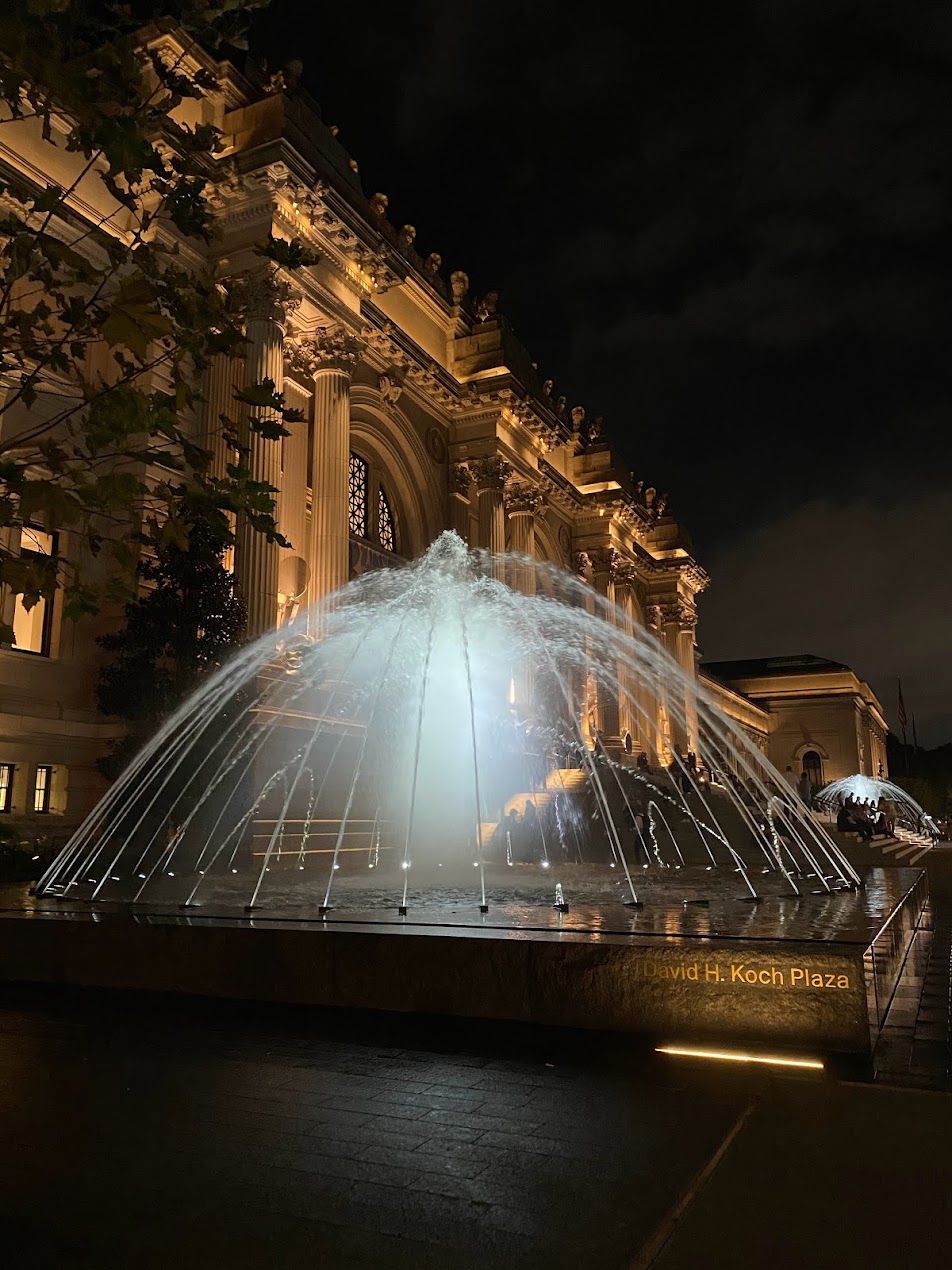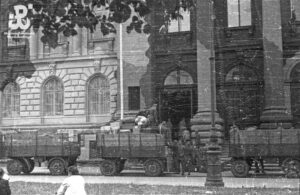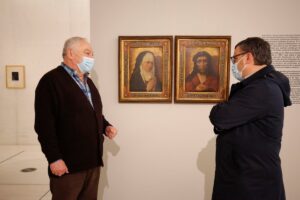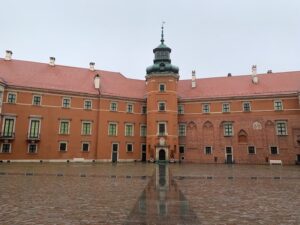by Amineddoleh & Associates LLC | Sep 9, 2022 |
A New York bill signed into law on August 10, 2022 will require museums to provide a notice to viewers if works of art on display have links to the Holocaust. This groundbreaking and restorative legislation accompanies two other Holocaust-related bills signed into law: one aimed at increasing Holocaust literacy through curricula in educational institutions, and the other designed to increase pressure on banks that assess fees related to Holocaust reparations. All three bills work in concert to combat rising reports of antisemitism through these targeted cultural, economic, and educational channels.
Provenance
While other states are considering enacting similar legislation to increase Holocaust literacy in schools, New York stands apart in dictating these trailblazing requirements for museums to publicly acknowledge the devastating conditions under which they may have acquired certain works. The origin of a work of art is known as its provenance, and its applicability extends beyond Holocaust-era stolen works (you can access our blog post on the fight to prove provenance for Mexican antiquities here). Provenance is important not only to establish a chain of title when purchasing a work, but also to determine its cultural, political, and financial value.
Proving provenance is no small task, particularly when items have been stolen. This task is rendered even more difficult when the theft occurred during or shortly after the chaos of war. In the case of works stolen during the Holocaust, both these hurdles were present, with the added complications of global economic upheaval, unimaginable human suffering, an overwhelming refugee crisis, and the genocide of the class of people from whom the works were primarily stolen. The process of proving provenance for works stolen during WWII typically involves the heirs of deceased Jewish family members bringing claims to museums in hopes of establishing legitimate ownership of works held by a museum through whatever documents were salvaged after the war. This can include references in letters and diaries, family photographs, and bills of sale. The museum then has its own systems to determine the legitimacy of such claims. If provenance is not proven after the museum’s internal investigation, the museum is then able to claim that it “legally” retains the artwork.
 Of course, this is devastating news to families seeking to reclaim an important piece of family heritage. If a museum denies heirs’ claims, they may proceed to file litigation. One high-profile example is Gustav Klimt’s portrait of Maria Altmann, titled Woman in Gold. Another is the ongoing Cassirer case, involving the Museo Thyssen-Bornemisza in Madrid. However, these cases often take years – if not decades – to resolve, leaving the artwork in legal limbo until a final decision or settlement is made.
Of course, this is devastating news to families seeking to reclaim an important piece of family heritage. If a museum denies heirs’ claims, they may proceed to file litigation. One high-profile example is Gustav Klimt’s portrait of Maria Altmann, titled Woman in Gold. Another is the ongoing Cassirer case, involving the Museo Thyssen-Bornemisza in Madrid. However, these cases often take years – if not decades – to resolve, leaving the artwork in legal limbo until a final decision or settlement is made.
It is important to keep in mind that Gov. Hochul’s new law does not specifically address the need to return works to individual families (restitution). However, it does bring to light the importance of acknowledging a work’s provenance as an important cultural indicator of the suffering of a class of people, even if it does not repair the harm done to individual families. Thus, the heirs or successors-in-interest of a dispossessed owner will need to rely on alternative avenues to recover their property.
Restitution
The effect of the public notice requirement speaks to justice outside the courts that can be accomplished through the voluntary restitution of stolen artwork. When restitution is carried out by leading art institutions as part of a larger “duty to remember,” it aids in cultivating peace and strengthening non-legal measures of restitution. Furthermore, it sets a positive example for other art world participants. While public art institutions have often not returned potentially looted art to the heirs of their original owners when proof of theft is not evident, many have expressed a desire to not retain stolen work. Even so, museums as a whole tend to be reluctant to part with prized pieces, particularly when the works claimed as stolen are the very ones that draw visitors to their galleries.
Case law
 Decades of case law in the U.S. indicate the difficulties facing claimants. Recent cases against New York museums resulted in wins for the institutions, yet not due to the merits of each respective case. Rather, the Museum of Modern Art squeaked out wins through a confidential settlement, and defended itself by claiming that the statute of limitations had run. In another case, the Metropolitan Museum of Art made the affirmative defense of laches, under the theory that claimants made an unreasonable delay in bringing suit against the museum for a valuable painting by Picasso.
Decades of case law in the U.S. indicate the difficulties facing claimants. Recent cases against New York museums resulted in wins for the institutions, yet not due to the merits of each respective case. Rather, the Museum of Modern Art squeaked out wins through a confidential settlement, and defended itself by claiming that the statute of limitations had run. In another case, the Metropolitan Museum of Art made the affirmative defense of laches, under the theory that claimants made an unreasonable delay in bringing suit against the museum for a valuable painting by Picasso.
Even the most recent ruling in the Guelph Treasure litigation did not fare well for the claimant heirs. The Guelph Treasure litigation follows claims brought by the heirs to a priceless haul of German ecclesiastical relics, currently on display in the Bode Museum in Berlin. The heirs claim that the relics were sold under duress to the Nazi government in 1935 for less than their market value. The museum’s foundation argues that the sale was voluntary, and, further, was not made under the pressure of Nazi occupation in Germany.
Last month’s ruling by the District Court for the District of Columbia dismissed the case on jurisdictional grounds, stating that the Foreign Sovereign Immunity Act (FSIA) blocked suit of Germany in U.S. court (this confirms the holding by the U.S. Supreme Court that remanded the matter to the district court). The claimants relied on an exception to the FSIA which prohibits expropriations that violate international law, arguing that dispossession in cases of genocide qualified for this rule. However, the court found that the claimants failed to prove that their ancestors were not German nationals at the time of the sale, meaning that only domestic law – not international law – was involved. As such, U.S. courts do not have subject matter jurisdiction over the matter, meaning that U.S. courts are unable to make determinations on German domestic law.
The district court’s decision does not eliminate the possibility of appeal or further pursuit of the Guelph Treasure through alternate measures in Europe. However, claimants often prefer to file disputes in the U.S. because American courts have historically been more lenient for Holocaust-related actions, particularly on statute of limitations grounds. In most European countries, causes of action for property stolen or lost during WWII have already expired. For example, Poland recently passed legislation that reduced the statute of limitations on all restitution cases to 30 years from the theft’s occurrence; this effectively bars all Holocaust restitution claims.
It is important to note that not all hope is lost. Some museums have, on their own initiative, refused to turn a blind eye to the problematic origins of some of their beloved works. The North Carolina Museum of Art, for example, returned a 16th-century painting by Lucas Cranach the Elder to an Austrian family after learning that the work was stolen by Nazi officials in 1940. And the Museum of Fine Arts in Boston (MFA) recently returned View of Beverwijk by Salomon van Ruysdael to the descendants of a Jewish art collector and politican, from whom the work was stolen by Nazi forces.
In the case of the return of View of Beverwijk, the museum and the claimant family each had a role in making the restitution possible. First, the MFA received new provenance information regarding the work and updated its museum website. The family’s lawyer then used that new information to provide a missing link to prove their ancestor’s possession.
It was truly a moment of teamwork, and sets an example for other museums seeking to actively become part of the solution in remedying the trauma of the Holocaust. The MFA’s curator for provenance, Victoria Reed, stated (upon the return), “To be able to redress that loss, even in a tiny way, I think, is gratifying. And it certainly is part of what we should be doing as a museum.”
At the same time, voluntary returns of artwork by museums are few and far between, and the battle for individuals seeking to prove provenance remains a lengthy, cumbersome, expensive, and uphill battle. In light of these hurdles, requiring museums to publicly notify guests of the potentially tragic origins of works they have on display is a start. Doing so gives voice to the people who were silenced under the traumatic and systematic genocide of the Holocaust and lost their homes, families, and ties to their history and culture.
New York’s actions, in this sense, are an act of strength in the face of the general reluctance by museums to acknowledge that there are times in which the display of art may perpetuate war crimes. As Maya Angelou put it, “History, despite its wrenching pain, cannot be unlived. But if faced with courage, need not be lived again.”
by Amineddoleh & Associates LLC | Aug 23, 2021 |
In the latest entry of our firm’s ongoing Provenance Series, we discuss a new Polish law that will likely have serious negative implications for claimants seeking the return of property looted during the Second World War. In order to understand the context giving rise to this law, we delve into the country’s history of cultural heritage looting from 1939-1993, recent restitution cases, the provenance of the famous Czartoryski Collection, and the potential effects of Poland’s new law on lawsuits involving Nazi looted art and cultural heritage.
The Sacking of Poland’s Cultural Property During and After WWII

Germans looting the Zachęta Museum in Warsaw in the summer of 1944
It has been estimated that Poland suffered the staggering loss of 70% of its tangible cultural heritage during WWII at the hands of both the Nazis and the Soviet Union. This unprecedented loss amounts to approximately 500,000 cultural objects; many still unaccounted for, including masterpieces by Raphael, Albrecht Durer, Rembrandt, and other beloved Old Masters. The looting campaign was systematic, as the Nazis had a plan in place before invading Poland in 1939. Seizures were overseen by high-ranking officials, and then exacerbated by the Soviet Army and its subsequent decades-long occupation. Although the Nazis kept extensive documentation of their newly acquired spoils, much of the goods and records were lost during their evacuation of the Polish territories in 1944 and the ensuing turmoil. While the confiscations involved many Jewish families, not all property belonged to this minority; Christians, Roma, and political dissidents were also targeted. To illustrate, in 2007 a Polish count made a claim to a medieval cross worth $500,000 that was found in the trash in Austria, which had previously been forcibly removed from Poland. (The count is a member of the aristocratic Czartoryski family, whose collection is discussed below.)
Thus, restitution is a complex and sensitive subject given the horrific scale of suffering experienced by the Polish population both during and after WWII. A core factor complicating the return of cultural objects is the confiscation of such items by the Communist regime in the years after WWII, as Poland was not considered a sovereign nation with the capacity to enforce its national laws, particularly with respect to private property, until 1993. In some ways, the Communist mentality is still felt with regards to state-controlled property, including cultural objects. It is important to note that under Poland’s patrimony laws, dating as far back as 1918, cultural heritage is generally considered sovereign property. Therefore, recovery efforts are typically aimed at tracking down works for future custody and display in national museums and collections.
An additional obstacle is that class action suits to recover property from victims without heirs are regarded as incompatible with Polish law, as in the case of international Jewish organizations that claim property taken from Jews that have no living descendants. All these factors have resulted in Poland lagging behind other countries regarding the restitution of WWII-looted objects, despite some success stories (discussed below), and their cooperation with international organizations and law enforcement. Overall, the restitution process is expensive and time consuming for claimants, and the new law imposing a strict statute of limitations on claims will create further hindrances.
Polish Law and Difficulties in Returning Nazi Looted Cultural Heritage

Portrait of a Seated Woman by Thomas Couture (Photo courtesy of the German Lost Art Foundation)
Over the past decade, the Polish government has increased its efforts to recover looted cultural items from collections abroad. In 2011, the Polish Ministry of Culture and National Heritage’s Division of Looted Art created a website to publicize its recovery efforts and assist in identifying missing works. The Division manages the only national cultural database of wartime losses and has gathered information on over 63,000 objects including paintings, coins, vehicles, sculpture, books, maps, toys, carpets, furniture, metalwork, and jewelry, among other items of artistic, historical, and sentimental value. The public can also access the list of recovered artworks online and use the Art Sherlock app to identify stolen or looted works. In 2012, it was announced that one of the most famous missing pieces, Raphael’s Portrait of a Young Man, had been supposedly found in a bank vault in an undisclosed location. However, it still has not entered the public eye. (One of our previous blog posts discusses the provenance of this fascinating work in more detail.) Moreover, this type of information gathering is time-consuming and requires both willing participation and accurate data. Collectors, dealers, and purchasers may be wary of publicly submitting such details if they come to realize that the provenances of works in their possession are problematic.
Another challenge for restitution claims is the applicable statute of limitation. Statutes of limitation are meant to ensure that a party is not prejudiced by another party’s undue delay or inaction in making a claim. In theory, this helps prevent false or outdated claims from commencing after proof has been lost or blurred by the passage of time. However, the strict application of statutes of limitations to Nazi looted property seems unjust and unfair, as a stolen item’s whereabouts are typically unknown for extended periods of time. If a private collector is in possession of such items, they may be hidden for years away from public view. Unless they are sold on the open market, for all intents and purposes, the works will have disappeared.
The Gurlitt Trove
A notorious example of this phenomenon is the “Gurlitt Trove,” containing nearly 1,400 works worth approximately $1.35 billion and which was discovered in 2012. Cornelius Gurlitt inherited the pieces from his father, an art dealer linked to the Nazis, and stashed them away for decades. After a chance cash check during a train journey, authorities became suspicious of tax evasion and raided Gurlitt’s apartment where they found a treasure trove or art. Gurlitt refused to return the works and argued that lawsuits would be blocked on statute of limitations grounds. Under German law, if a court found that Gurlitt was a good faith purchaser, he would have been entitled to keep the objects. Gurlitt ultimately reached an agreement with the Bavarian state prosecutor to return certain works to the heirs of their former owners. After his death in 2014, it was discovered that Gurlitt had bequeathed his collection to a Swiss museum. The German Lost Art Foundation, an organization founded by the German government, spent the next 6 years performing provenance research on the collection and identified several looted works that were then returned. These included Portrait of a Seated Woman by Thomas Couture (returned in January 2019 due in part to a tiny detail in the work) and Quai de Clichy by Paul Signac (returned in July 2019). Sadly, only a handful of works have been restituted to date because of the difficulty in obtaining accurate provenance information.
The Gurlitt controversy demonstrates that applying strict time limitations to claims may undermine the purpose of Holocaust-related restitution doctrines, which is to seek justice for those who were violently targeted by the Nazis. The Washington Conference Principles on Nazi-Confiscated Art, drafted in 1998, encourage participating nations to return looted art to original owners or their heirs. Steps should be taken to achieve a just and fair solution, according to the circumstances of each specific case. While these principles are non-binding, they recognize that moral claims have a role to play in lawsuits concerning Nazi looted cultural property.
New Legislation in Poland
These issues have now been exacerbated by recent Polish legislation. Just this month, Polish President Andrzej Duda signed a law reducing the statute of limitations on all restitution cases to 30 years since the theft’s occurrence. In practical terms, this means that restitution of Nazi-looted items will become impossible since the thefts occurred nearly 80 years ago. Both the U.S. and Israeli governments, in addition to many cultural heritage experts, have denounced the decision. Although the law was criticized as “immoral” and a “disgrace,” the Polish government has defended its actions by saying that the new rules aim to end fraud and stop irregularity concerning property restitution, which the President terms “an era of legal chaos.” Last week, our founder was quoted in Artnet regarding the “overwhelming obstacles” victims in restitution cases face, including how proving legal title to stolen art decades later in a court of law is a tremendous challenge. The new law fails to account for these obstacles and the practical difficulties in overcoming them.
The Polish legislature could potentially carve out an exception for Holocaust looted property to prevent outstanding claims from being blocked, but the current law treats all property equally. The law has additionally been characterized as problematic for seemingly undermining Poland’s own efforts to recover cultural items at the national level. We discuss recent examples of returned Polish cultural property in the following two sections as a counterpoint to the new law.
A Spanish Museum Returns Flemish Paintings to Poland
 Earlier this year, the Museum of Pontevedra in Spain announced that it would return two paintings by Flemish artist Dieric Bouts to Poland. The late 15th Century works depict the Virgin of Sorrows and Jesus Christ in his Ecce Homo aspect. They were purchased from one of the museum’s patrons who likely acquired them from a Spanish dealer in the 1970s. The paintings were displayed openly for years, without any suspicion regarding their origins. Then, in late 2019 the museum was alerted by Polish authorities that the paintings closely resembled ones looted by the Nazis that were destined as a gift for Hitler. It is unclear when or how the paintings arrived in Spain, but it is certain that they were taken by the Nazis from the medieval Goluchów Castle in Poznan since they appeared in a German inventory of the country’s most valuable cultural items during WWII. After receiving notification from Poland, the museum engaged a team of experts to examine the works, which were found to match the missing items.
Earlier this year, the Museum of Pontevedra in Spain announced that it would return two paintings by Flemish artist Dieric Bouts to Poland. The late 15th Century works depict the Virgin of Sorrows and Jesus Christ in his Ecce Homo aspect. They were purchased from one of the museum’s patrons who likely acquired them from a Spanish dealer in the 1970s. The paintings were displayed openly for years, without any suspicion regarding their origins. Then, in late 2019 the museum was alerted by Polish authorities that the paintings closely resembled ones looted by the Nazis that were destined as a gift for Hitler. It is unclear when or how the paintings arrived in Spain, but it is certain that they were taken by the Nazis from the medieval Goluchów Castle in Poznan since they appeared in a German inventory of the country’s most valuable cultural items during WWII. After receiving notification from Poland, the museum engaged a team of experts to examine the works, which were found to match the missing items.
The museum indicated it would return the works to Poland. Polish authorities commended the museum’s willingness to do so voluntarily, even though it had acquired them in good faith (as such, the museum had a legal claim of ownership under Spanish law). The case was cited as an example of integrity and transparency. César Mosquera, vice president of the Pontevedra city council, announced that they were proud to return these works in light of their dark origins.
The Provenance of the Czartoryski Collection

Lady with an Ermine, Leonardo da Vinci
The famed Czartoryski Collection has reached mythical proportions in Poland, not only due to the breadth of its works, but also the family’s travails. This aristocratic family is closely tied to the political and cultural history of the Polish state. In 1796, Princess Izabella Czartoryska opened the first Czartoryski Museum at her residence in Pulawy, showcasing her antiques and paintings. Leonardo da Vinci’s Lady with an Ermine and Raphael’s Portrait of a Young Man formed part of this esteemed group. During the Russian occupation of Poland in 1830, the family fled and ultimately resettled in Paris. While the Raphael painting was lost, the Princess saved the Leonardo by sending it 100 miles south to the Czartoryski palace at Sieniawa, before it joined the family in Paris. The Czartoryskis returned to Poland and opened another two museums by 1878, one in Warsaw and one in Goluchów Castle. The Castle collection consisted of over 5,000 decorative art objects and several hundred valuable paintings. In 1939, as the Nazis approached Poland, the widow of Prince Adam Ludwik Czartoryski removed the most valuable works from the castle, concealed them in 18 boxes, and hid them behind a wall in the wine cellar. However, Nazi officials coerced her into revealing the objects’ location. The Nazis confiscated the items and moved them to the National Museum of Warsaw in 1941, where they were inventoried and photographed. Some of the pieces were taken to Austria, while others were pillaged by deserters and refugees at the end of the war. Lady with an Ermine was fortunately returned in 1946, after its discovery by Allied soldiers (the Monuments Men) in Germany. Unfortunately, the collection was then under the Communists’ control until the fall of the Soviet Union. The family has spent decades attempting to track down their treasures. Prince Adam Karol Czartoryski, born and raised in Spain, has made it his life’s mission to recover what was stolen and established the Princes Czartoryski Foundation in 1991 for this purpose.
In 2016, the Prince signed an agreement with the Polish government selling the collection of 86,000 artworks and 250,000 historic manuscripts to the state for €100 million (a fraction of its total value). It was considered a tremendous bargain for Poland, and the sale was hailed as a donation. The agreement stipulated that the National Museum in Krakow would control the buildings owned by the Czartoryski family and used for the display of the works, and the collection was made publicly available in 2019 after extensive renovations. Despite some controversy over the nature of the purchase, the collection now attracts visitors from all over the world. The government also signed a separate agreement with the Czartoryskis for the acquisition of Goluchów Castle and its art collection. However, the family retains the right to make claims for the return of still-missing looted cultural objects, estimated at 800 pieces. This means that cases involving the Czartoryski collection could arise in the future, whether in Poland or abroad.
The Future of Polish Restitution and its Effects in the U.S.

Warsaw Castle (photo courtesy of Claudia Quinones)
Poland has received criticism for lacking viable procedures to process restitution claims from Holocaust victims, within the country and from abroad. It has also failed to uphold the Washington Principles despite benefiting from restitution laws of other nations, including the U.S. This, combined with the new law’s restrictive statute of limitations, may prompt claimants to file lawsuits in more forgiving jurisdictions, such as the U.S. (however, jurisdictional challenges remain for claimants to prove proper jurisdiction within the U.S.). Restitutions of Nazi-looted art involving foreign claimants have become prominent in the U.S., including the well-known cases of the Altmann family’s claim to Klimt’s Lady in Gold and the ongoing Guelph Treasure litigation. The statute of limitations for theft in general may be tolled under the Demand and Refusal Rule or the Discovery Rule. The Demand and Refusal Rule, which only applies in New York, holds that the statute of limitations begins to run when the original owner demands restitution, and the current possessor refuses to return the object. The Discovery Rule deems that time begins to run when an owner knows or reasonably should know the location of the object.
At the federal level, U.S. Congress passed the Holocaust Expropriated Art Recovery Act of 2016 (HEAR Act) providing a 6-year statute of limitations for Nazi looted cultural property that does not begin to run until the object in question is actually discovered and knowledge of it is obtained. This is more favorable for claimants, allowing them greater opportunity to make plans of action for restitution. Notably, the Act has the potential for cases that were previously barred under statute of limitations rules to be “resuscitated” in special circumstances. However, while the Act replaces state and federal statutes of limitations for art recovery claims with a uniform period to make a claim, this is only temporary (until 2026).
The HEAR Act also allows claimants to side-step the good faith purchaser loophole present in many countries, including Poland. The U.S. follows the nemo dat rule, holding that a thief cannot transfer good title to stolen property. This fault in title continues to taint subsequent purchasers. If claimants have a connection with the U.S., they may be able to file a suit for the restitution of looted cultural property there, even if the object is located in another state such as Poland. Likewise, Poland could appear in a U.S. court to request repatriation if there is sufficient nexus, or the nation may request assistance from U.S. authorities. For example, in 2014, the FBI was contacted by Poland and tracked down 75 paintings by a Polish resistance fighter who moved to San Francisco after escaping a concentration camp. Although Poland’s law may affect domestic claims, the door remains open for international cooperation, which may have a more favorable outcome.
The effects from the Polish law remain to be seen, but there is no stemming the tide of restitution for Nazi looted cultural heritage. Although countries have experienced setbacks with restitution claims, cultural heritage attorneys will continue to seek justice in the face of procedural and legal hurdles.
 Of course, this is devastating news to families seeking to reclaim an important piece of family heritage. If a museum denies heirs’ claims, they may proceed to file litigation. One high-profile example is Gustav Klimt’s portrait of Maria Altmann, titled Woman in Gold. Another is the ongoing Cassirer case, involving the Museo Thyssen-Bornemisza in Madrid. However, these cases often take years – if not decades – to resolve, leaving the artwork in legal limbo until a final decision or settlement is made.
Of course, this is devastating news to families seeking to reclaim an important piece of family heritage. If a museum denies heirs’ claims, they may proceed to file litigation. One high-profile example is Gustav Klimt’s portrait of Maria Altmann, titled Woman in Gold. Another is the ongoing Cassirer case, involving the Museo Thyssen-Bornemisza in Madrid. However, these cases often take years – if not decades – to resolve, leaving the artwork in legal limbo until a final decision or settlement is made. Decades of case law in the U.S. indicate the difficulties facing claimants. Recent cases against New York museums resulted in wins for the institutions, yet not due to the merits of each respective case. Rather, the Museum of Modern Art squeaked out wins through a confidential settlement, and defended itself by claiming that the statute of limitations had run. In another case, the Metropolitan Museum of Art made the affirmative defense of laches, under the theory that claimants made an unreasonable delay in bringing suit against the museum for a valuable painting by Picasso.
Decades of case law in the U.S. indicate the difficulties facing claimants. Recent cases against New York museums resulted in wins for the institutions, yet not due to the merits of each respective case. Rather, the Museum of Modern Art squeaked out wins through a confidential settlement, and defended itself by claiming that the statute of limitations had run. In another case, the Metropolitan Museum of Art made the affirmative defense of laches, under the theory that claimants made an unreasonable delay in bringing suit against the museum for a valuable painting by Picasso. 

 Earlier this year, the Museum of Pontevedra in Spain
Earlier this year, the Museum of Pontevedra in Spain 

